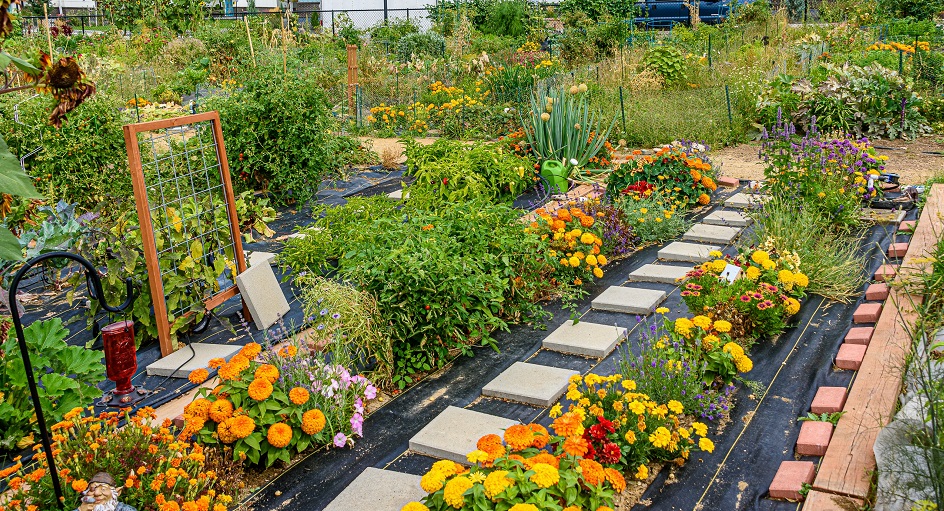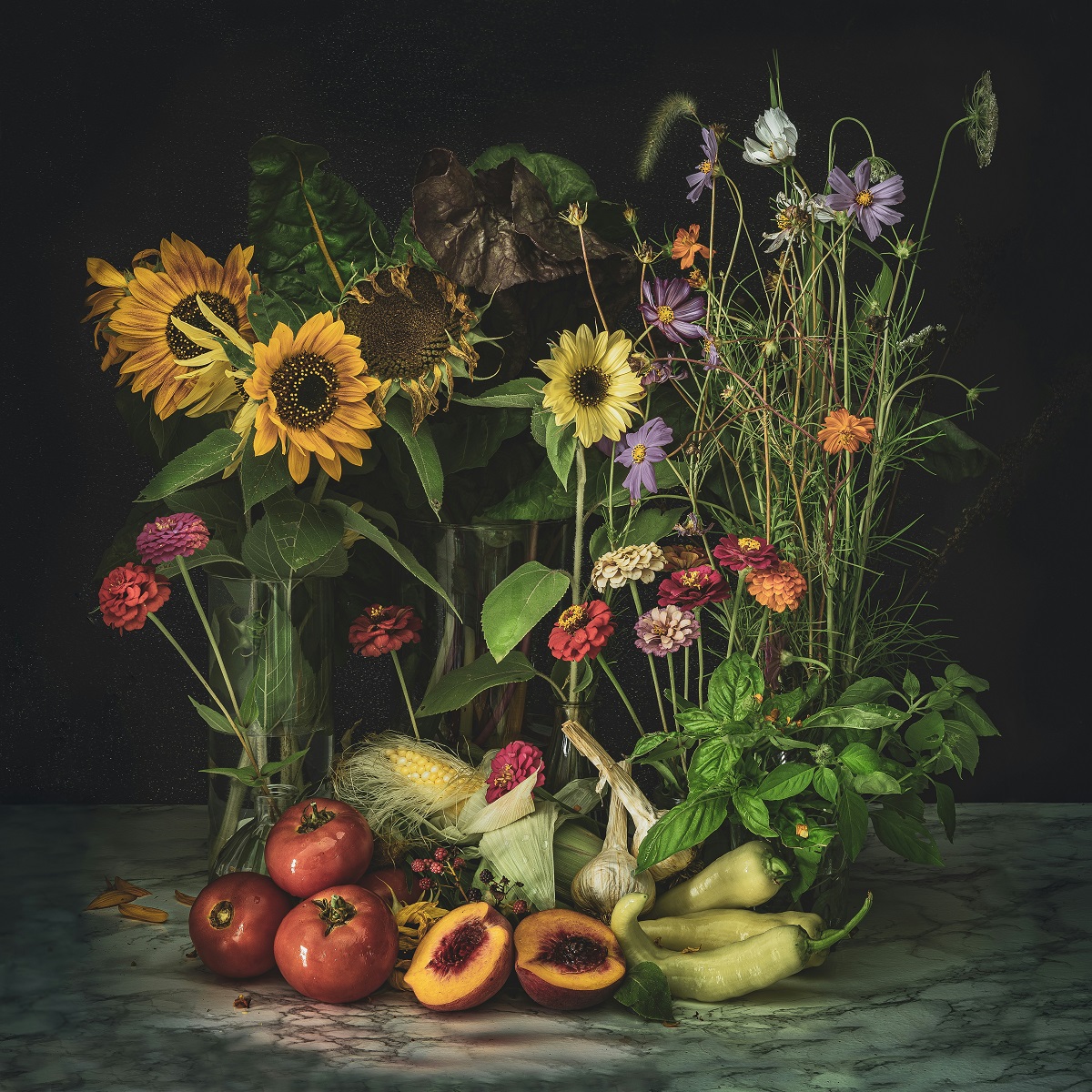
Make Your Food Garden Beautiful!
Creating a beautiful food garden combines functional elements with aesthetic appeal to cultivate an attractive and productive space. Start by planning your garden layout with functionality, considering factors like soil quality, irrigation and water access, drainage, and direct sunshine. There should be designated areas for your fruits, vegetables, and herbs because each type of food will need special care and variation in growing environments.
When it comes to creating a visually appealing food garden, it’s all about the details. One way to add depth and structure to your garden is by using raised beds, containers, trellises, and borders. These elements not only delineate between spaces but also create visual interest and an aesthetically pleasing design. These features will make your garden stand out before you even think about adding flowers or attractive plants. They also cultivate dimension, giving your garden a 3D look that leads the eyes on an adventure. So, treat your food garden as a work of art and make it as much a visual masterpiece as it is a functional place for your dinner side dishes.
A well-maintained, well-organized garden is beautiful, so keep your space mulched, weeded, and tidied. You can also incorporate edging around your garden beds, such as designated stones or bricks, to maintain clean lines that serve as clear, aesthetically appealing separations between your garden and the rest of the yard.
If you like these gardening tips, read on for more ways to make your food garden beautiful.
Add Pops of Colorful Blooms and Blossoms
Regardless of kind, gardens are a lot of hard work, and achieving the look and feel you want for your food garden can give you a distinct feeling of accomplishment.
Adding your favorite flowers to a food garden can bring bursts of color that catch the eye and uplift the spirit. Color is deeply connected to our emotions, and vibrant red, sunshine yellow, citrus orange, and pretty purple blooms can create a joyful atmosphere. Seeing a blossoming garden in springtime is a surefire way to bring a smile to your face.
Some flowery ideas to beautify your food garden include:
- Cornflowers—these flowers bloom in cheerful blue, pink, white, and purple patches.
- Zinnias—these flowers have long-lasting blooms in all colors, shapes, and sizes.
- Cosmos—these flowers are easy to grow and bloom annually in various shades of red, white, pink, and purple.
- Lemon balm—these flowers add subtle beauty with small white or pale pink blossoms.
- Lavender—these flowers are abundant and fragrant in pale to royal purple shades.
Incorporating flowers into a food garden can enhance its beauty while supporting overall garden health. They can be as beneficial to your food garden as they are pleasing to those who pause to admire them.
Be Kind to Bees and Butterflies
Pollinators play a vital role in food gardens because they facilitate the reproduction of fruits, vegetables, and herbs by transferring pollen from one flower to another. Plants like cucumbers, apples, berries, squash, and tomatoes rely heavily on pollinators like bees and butterflies, so it’s important to add plants that welcome these insects into your garden.
For instance, bee balm, also known as bergamot, produces beautiful tubular flowers that are highly attractive to bees. The blooms, prevalent in mid to late summer, are rich in nectar, making them a reliable pollinator food source.
Other attractive plants for bees and butterflies include:
- Catmint—this plant produces spikes of lavender flowers and is proven irresistible to bees in the spring through autumn.
- Purple Coneflowers—this daisy-like flower features a prominent raised center, abundant in pollen and nectar.
- Sunflowers—these impressive, sunshiny flowers produce large amounts of nectar and pollen throughout summer.
- Butterfly Bushes—this bush blossoms from summer to autumn in fragrant flower clusters, abundant in nectar. Butterflies of all kinds will flit into your garden, but these bushes are especially loved by painted ladies, swallowtails, and monarchs.
- Asters—the flowers look like daisies in vibrant colors that are attractive to butterflies and other pollinators looking for plentiful nectar.
When planning your food garden to attract bees, butterflies, and other pollinators, aim to provide various flowering plants that bloom throughout the growing season. This ensures that pollinators have a continuous source of food and habitat, which is good news for your fruits, vegetables, and herbs.
Consider Vibrant, Beneficial Native Plants
Native plants are beneficial to your garden ecosystem and the environment as a whole. Not only are they pollinator attractants, but they provide habitats and food sources for native wildlife, like robins and bluebirds. They help create a healthy, balanced ecosystem in your garden.
Did you know native plants have evolved natural defenses against garden pests? Thus, they are more resistant to damage and infestation, protecting your food garden. Incorporating native plants into your garden can also reduce the need for chemicals and pesticides, naturally repelling the nasty bugs and attracting the good ones.
Native plants are diverse in their beauty, blooming in various colors that add visual appeal to your food garden. Additionally, many native plants can thrive in existing soil and conditions, creating a low-maintenance garden that flourishes with minimal intervention.
Go Vertical!
Planting vertical plants in a food garden maximizes space, increases plant productivity, and adds visual interest to your landscape. Growing crops upwards involves using stakes, fences, or trellises; in some cases, you can utilize vining or climbing plants on walls for extra visual appeal.
The following edible plants look beautiful in bloom and can grow vertically.
- Most tomato varieties are suitable for vertical gardening. Use sturdy trellises, cages, or stakes to support the vines and keep them off the ground for better air circulation and disease prevention.
- Excellent candidates for vertical food gardening, these have long, vining stems that can crawl upwards on A-frames or netting. Growing them vertically helps prevent rot and pest damage.
- Melons and Squash. While some varieties need additional support due to weight, you can use slings or hammocks to help squash and melon vines grow upward. Keeping the fruit off the ground allows them to flourish without being eaten by pests.
- Like pumpkins, gourds are climbing plants that can look decorative while also being edible. Use arbors and other vertical structures to support vines and guide them upwards. Vertical food gardening will help with better airflow, sunlight penetration, and promotion of interior fruit development.
Adequate support structures can add depth and layers to your food garden, making it a lovely place to work and spend time. Try it and see if this makes your food garden beautiful!
Learning More About Making Your Food Garden Beautiful
When we talk about sustainable living, we talk about the long-term health and wellness of people and the planet. We are talking about eco-friendliness, environmental respect, and respect for yourself and those around you. Sustainable living encompasses many aspects of daily life, and a sustainable, beautiful food garden is one way in which you can choose to live harmoniously with wildlife and the Earth.
Creating a sustainable, beautiful food garden involves practices that minimize environmental impact, conserve resources, and promote long-term biodiversity. To make an even more sustainable food garden, practice organic gardening methods. Crop rotation, companion planting strategies, and minimal use of synthetic chemicals are great ways to get started.
Want to learn more about gardening strategies and sustainable living practices? Come to the Stoney Creek Farm Sustainable Farm Conference on October 5th, 2024, for a one-day, jam-packed learning event.


